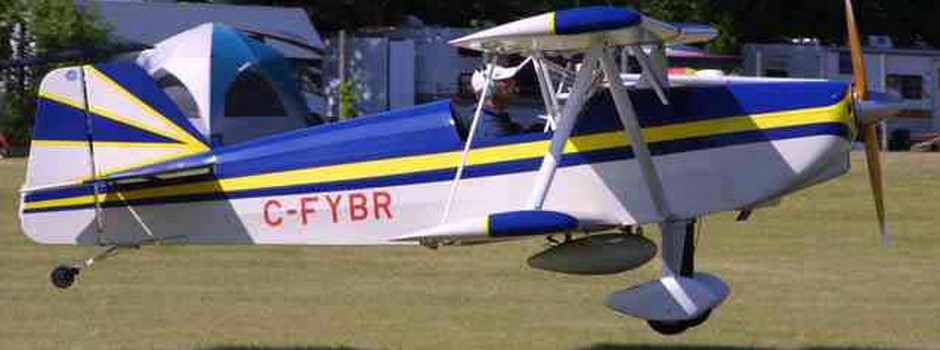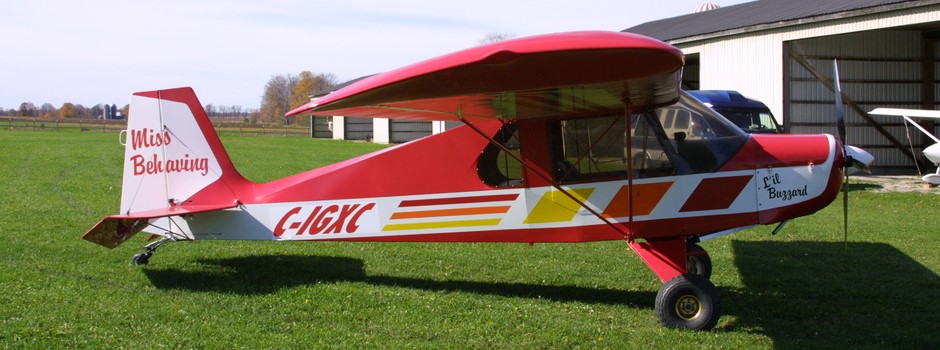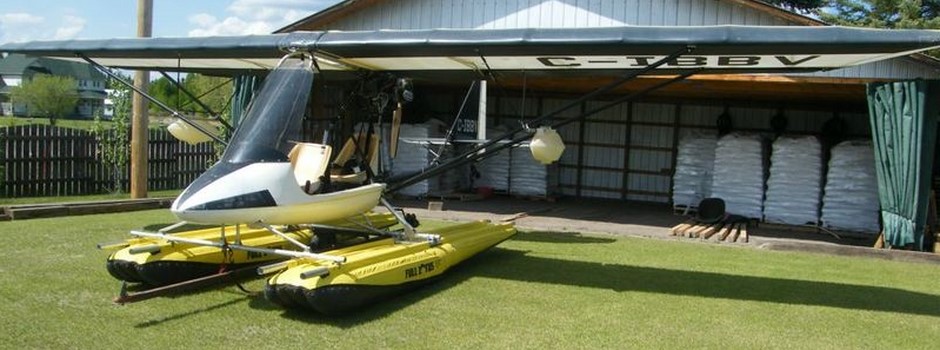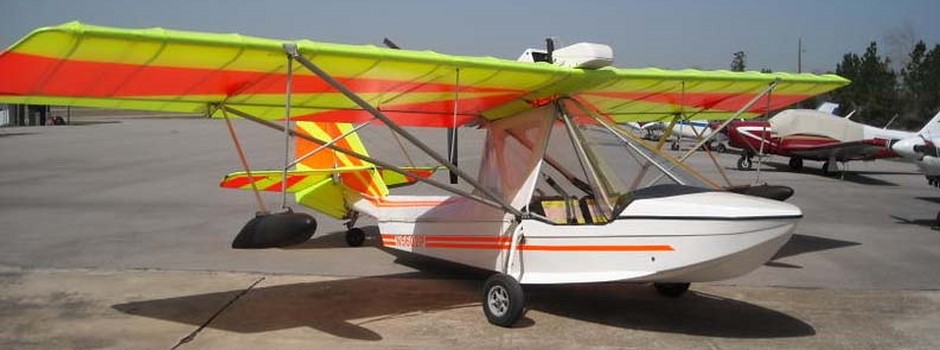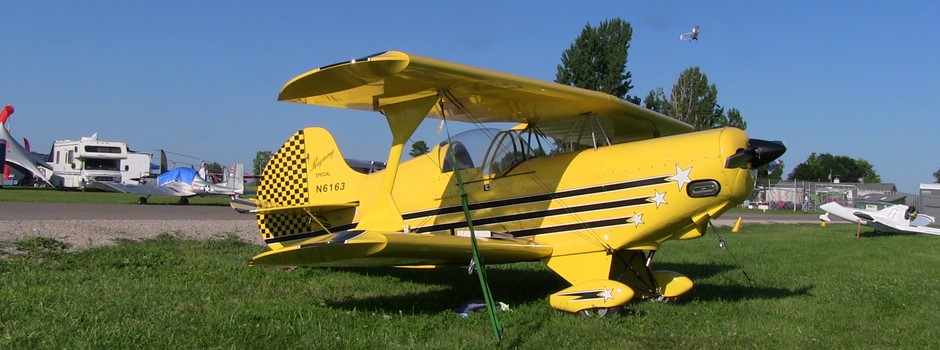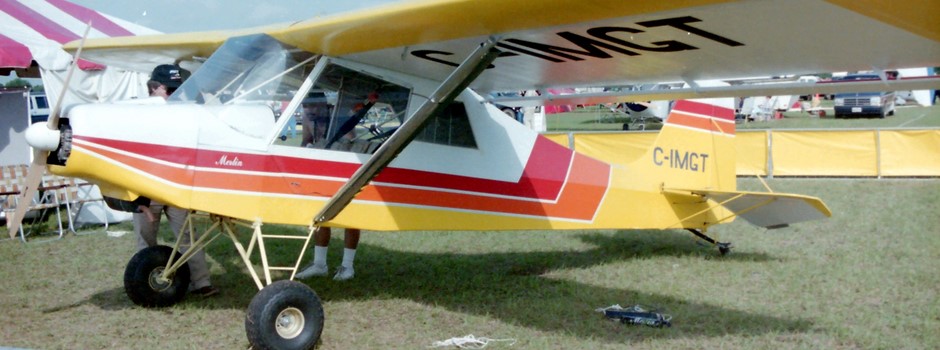Canadian Ultralight Aircraft, basic single seat,two seat and advanced ultralights.
Use the top navigation bar to navigate Ultralight Aircraft Canada site!
A basic ultra-light aeroplane In Canada is defined as either:
- A basic ultra-light aeroplane is defined as either:a single-seat aeroplane that has a launch weight of kg (363.8 pounds) or less, and a wing area, expressed in square metres, of not less than the launch weight minus 15, divided by 10, and in no case less than 10 m2",
- a two-seat instructional aeroplane that has a launch weight of 195 kg (429.9 pounds) or less, and a wing area, expressed in square metres, of not less than 10 m2 and a wing loading of not more than 25 kg/m2 (5.12 pounds/ft.2), the wing loading being calculated using the launch weight plus the occupant weight of 80 kg (176.4 pounds) per person, or an aeroplane having no more than two seats, designed and manufactured to have a maximum take-off weight of 544 kilograms and a stall speed in the landing configuration (Vso) of 39 knots (45 mph) or less indicated airspeed at the maximum take-off weight.
An advanced ultra-light aeroplane in Canada is defined as:
- an aeroplane that has a type design that is in compliance with the standards specified in the manual entitled Design Standards for Advanced Ultra-light Aeroplanes.
- An advanced ultra-light aeroplane does not include powered parachute aircraft, trikes or powered gliders.
Registration - Manufacturer - Advanced Ultra-lights
Before an owner can register their aircraft as an advanced ultra-light aeroplane, each model of advanced ultra-light aeroplane that a manufacturer markets must appear on a Listing of Approved Advanced Ultra-light Aeroplanes, that is maintained by Transport Canada.
For an advanced ultra-light aeroplane to be added to this list, the following information must be supplied to the Recreational Aviation and Special Flight Operations division of Transport Canada.
- a Declaration of Compliance (DOC)
- a copy of the Manufacturer's Specified Maintenance Program
Owner Registration
Basic & Advanced Ultralights
Basic ultra-light and advanced ultra-light aeroplanes must be registered in Canada but are not issued with a flight authority document.
To become the registered owner, the applicant must meet the registration requirements found in subparts 200 - 202 of Part II of the Canadian Aviation Regulations (CARs).
Transport Canada application form number 26-0522 is used for the initial application for registration of an ultra-light or advanced ultra-light aeroplane.
The application (Part 2) of the certificate of registration is used by the new owner to apply for registration of a basic ultra-light or advanced ultra-light aeroplane.
Canadian Ultralight Aircraft Registration
The initial registration of an advanced ultra-light aeroplane requires the applicant to submit the following documents:
- Evidence of custody and control of the aeroplane such as a bill of sale, lease agreement or other acceptable document in accordance with Part II of the CARs;
- A completed Application for Registration of Ultra-light Aeroplane (Transport Canada form number 26-0522);
- A Statement of Conformity (SOC).
The registration marks that are issued to a basic or advanced ultra-light aeroplane will begin with "C-I???".
Pilot Permit - Ultra-light Aeroplane Canada
Section 421.21 of the CARs outlines the standards with regard to age, medical fitness and validity, knowledge, experience and skill relating to the acquisition a Pilot Permit - Ultra-light Aeroplane.
Section 401.05 deals with Recency Requirements which apply once a permit has been issued.
Powered Parachutes
When the experience requirements for a Pilot Permit - Ultra-light Aeroplane have been met, in whole or in part, on powered parachutes, the permit will be issued restricted to powered parachutes.
When the experience requirements for a Pilot Permit - Ultra-light Aeroplane have been met, in whole or in part, on powered parachutes, the permit will be issued restricted to powered parachutes.
Flight Instructor Rating - Canadian Ultra-light Aeroplane
The previous Commercial Pilot Licence - Ultra-light Aeroplane has been replaced by a Flight Instructor Rating endorsed on the Pilot Permit - Ultra-light Aeroplane. There is no change to the privileges. Ultra-light instructors can provide flight training on ultra-light aeroplanes (basic and advanced) towards the Pilot Permit - Ultra-light Aeroplane.
Canadian Ultralight Aircraft Operating Limitations
Basic and advanced ultra-light aeroplanes must be operated in Canada in accordance with section 602.29 of the CARs.
This section outlines general operating conditions as well as under what conditions an ultra-light aeroplane may be operated in controlled airspace. Ultra-light aeroplanes may not be operated at night or in IFR flight.
This section outlines general operating conditions as well as under what conditions an ultra-light aeroplane may be operated in controlled airspace. Ultra-light aeroplanes may not be operated at night or in IFR flight.
Canadian Ultra-light Aeroplane Uses
In addition to private recreational use a basic ultra-light and advanced ultra-light aeroplane may be used for hire and reward for the purpose of pilot flight training in accordance with section 406 of Part IV of the CARs.
A basic ultra-light or an advanced ultra-light aeroplane MAY NOT be used for any other commercial aviation operation or aerial work.
A basic ultra-light or an advanced ultra-light aeroplane MAY NOT be used for any other commercial aviation operation or aerial work.
Passenger Carrying in Ultra-light Aeroplanes
The CARs have not changed the privileges of the ultra-light pilot to incorporate the broader privileges allowed for by the Ultra-light Aeroplane Policy issued in 1991.
To address this, revised privileges for the ultra-light aeroplane pilot permit are set out in a General Aviation Policy Letter Number GA-97-15.
The Policy Letter allows for the operation of aeroplanes that are similar in design and performance to ultra-light aeroplanes and allows for the carriage of another person ONLY if that person holds a pilot document that affords them the privilege to fly an ultra-light aeroplane in Canada. i.e. an ultra-light pilot can carry another ultra-light pilot as a passenger.
The carriage of passengers is otherwise prohibited.
Passenger carrying in any aspect of aviation is a two-part equation.
Passenger carrying in any aspect of aviation is a two-part equation.
The first is that the aircraft must meet a recognized standard of design, construction and maintenance.
The second is that the pilot must be appropriately trained and have the privilege to carry a passenger.
In an advanced ultra-light aeroplane a passenger may be carried if the pilot holds a licence/permit providing passenger carrying privileges
i.e. a Pilot Permit - Recreational AND the advanced ultra-light aeroplane meets the following conditions:
- The aircraft is registered as an advanced ultra-light aeroplane;
- The advanced ultra-light aeroplane is maintained in accordance with the Manufacturer Specified Maintenance Program;
- The owner of the advanced ultra-light aeroplane has complied with any Mandatory Actions specified by the manufacturer;
- The advanced ultra-light aeroplane has not been modified without written approval from the manufacturer;
- A placard is installed in a location highly visible to the both occupants of the aircraft containing the following information:
THIS AIRCRAFT IS AN ADVANCED ULTRA-LIGHT AEROPLANE AND IS OPERATING WITHOUT A CERTIFICATE OF AIRWORTHINESS.
Failure to comply with these conditions will cause the aeroplane, where it meets basic ultra-light requirements, to revert to the basic ultra-light aeroplane category prohibiting the carriage of a passenger.
Where the aeroplane does not meet the requirements of the basic ultra-light category, the certificate of registration is cancelled in accordance with CAR 202.59.
for More Information on Canadian Ultralight Regulations Contact:
Recreational Aviation and Special Flight Operations is the division within Transport Canada’s Civil Aviation directorate which is responsible for amending and developing policies, standards and regulations concerning ultra-light and advanced ultra-light aeroplanes. You may contact us at:
Transport Canada
Recreational Aviation and Special Flight Operations (AARRD), Place de Ville, Tower C, 330 Sparks Street, 6th Floor, Ottawa, ON K1A 0N8
Telephone (613) 990-1034, Facsimile: (613) 990-6215, E-mail: recavsf@tc.gc.ca
Subscribe To The Ultralight Flyer Web Video Magazine.
Yearly Subscription To The Light Sport And Ultralight Flyer Web Video Magazine! ONLY $29.95. U.S.
Your subscription includes Rotax 582, and HKS aircraft engine rebuilding videos, which are EACH nearly 2 hours in length! PLUS hundreds and hundreds and hundreds of web video interviews with designers, manufactures, builders, and suppliers of ultralight light and light sport aircraft parts and accessories.
Subscribe To The Ultralight Flyer Web Video Magazine.
Subscribe to the Ultralight Flyer Web Video Magazine.
Lifetime Subscription To The Light Sport And Ultralight Flyer Web Video Magazine! ONLY $99.95. U.S.
Your subscription includes Rotax 582, and HKS aircraft engine rebuilding videos, which are EACH nearly 2 hours in length! PLUS hundreds and hundreds and hundreds of web video interviews with designers, manufactures, builders, and suppliers of ultralight light and light sport aircraft parts and accessories.
Your subscription includes Rotax 582, and HKS aircraft engine rebuilding videos, which are EACH nearly 2 hours in length! PLUS hundreds and hundreds and hundreds of web video interviews with designers, manufactures, builders, and suppliers of ultralight light and light sport aircraft parts and accessories.
